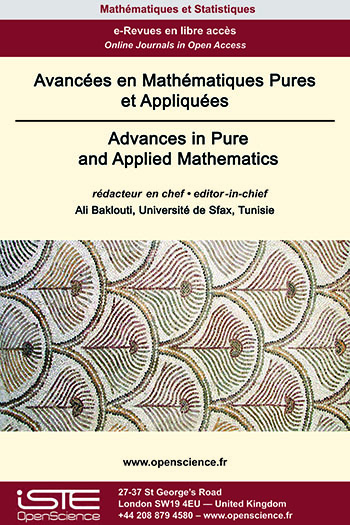

Mathematics > Home > Advances in Pure and Applied Mathematics > Issue
We develop topological partitions for m-to-1 local homeomorphisms on compact metric spaces—maps that arise naturally in non-invertible dynamical systems, such as expanding and covering maps. These partitions enable a symbolic representation of the dynamics via the zip shift, an extended bilateral shift in the non-invertible setting. Inspired by Smale’s horseshoe construction, this approach generalizes topological partitions to a broader class of systems and opens new directions for studying their topological and ergodic properties.
This paper presents a necessary and sufficient condition for a topological vector group to be locally compact. We also introduce several sufficient conditions that ensure the local compactness of topological vector groups. Furthermore, we establish a sufficient condition for a topological vector group to be first countable.
The generalized forms of Pitt’s inequality for the $$$L^p$$$-Gabor transform on the groups of the form $$$ℝ^n; ℝ^n \times K, K$$$ being a Lie group of type I, in particular, a connected nilpotent Lie group; Heisenberg motion group and diamond Lie groups have been established.
The Slater index (resp. decomposability index) of a tournament is the minimum number of arcs that must be reversed in that tournament in order to make it a total order (resp. indecomposable (under modular decomposition)). The first author [H. Belkhechine, Decomposability index of tournaments, Discrete Math. 340 (2017) 2986–2994] showed that for every integer $$$n \geq 5$$$, the decomposability index of the $$$n$$$-vertex total order equals $$$\left\lceil \frac{n+1}{4} \right\rceil$$$. It follows that the Slater index of an indecomposable $$$n$$$-vertex tournament is at least $$$\left\lceil \frac{n+1}{4} \right\rceil$$$. This led A. Boussaïri to ask the following question during the thesis defense of the second author on July 2, 2021: what are the indecomposable tournaments $$$T$$$ whose Slater index is minimum over all indecomposable tournaments with the same vertex set as $$$T$$$? These tournaments are then the indecomposable tournaments $$$T$$$ obtained from a total order by reversing exactly $$$\left\lceil \frac{v(T)+1}{4} \right\rceil$$$ arcs, where $$$v(T)$$$ is the number of vertices of $$$T$$$. In this paper, we characterize such tournaments by means of so-called irreducible pairings.
In this paper, we establish curvature estimates for a class of curvature equation $$$\mathcal{F}_{p}(\kappa)=f(V,\nu) for \frac{n}{2} \leq p \leq n-1$$$ in the warped product manifolds $$$\bar{M}$$$. Additionally, by imposing some constraints on the right-hand side function, we also obtain an existence result for the starshaped hypersurface $$$\Sigma$$$ that satisfies the above equation.
This paper is concerned with the nonlinear strongly damped wave equations involving the fractional Laplacian and regional fractional Laplacian with various boundary conditions. We first prove the existence and uniqueness of weak solutions using the compactness method and weak convergence techniques in Orlicz spaces. Then we study the existence and regularity of global attractors of associated semigroups. The main novelty of the obtained results here is to improve and extend the previous results in [6, 7, A.N. Carvalho and J.W. Cholewa] and [24, J. Shomberg].

2025
Volume 25- 16
Issue 1 (January 2025)2024
Volume 24- 15
Issue 1 (January 2024)2023
Volume 23- 14
Issue 1 (January 2023)2022
Volume 22- 13
Issue 1 (January 2022)2021
Volume 21- 12
Issue 3 (Special AUS-ICMS 2020)2020
Volume 20- 11
Issue 1 (May 2020)